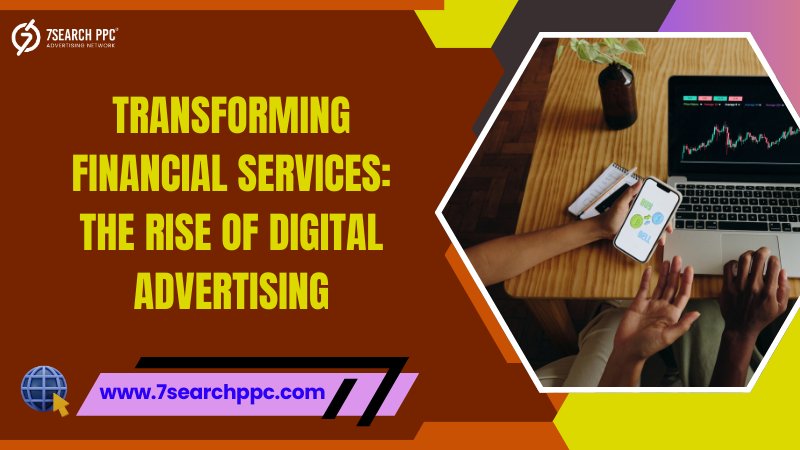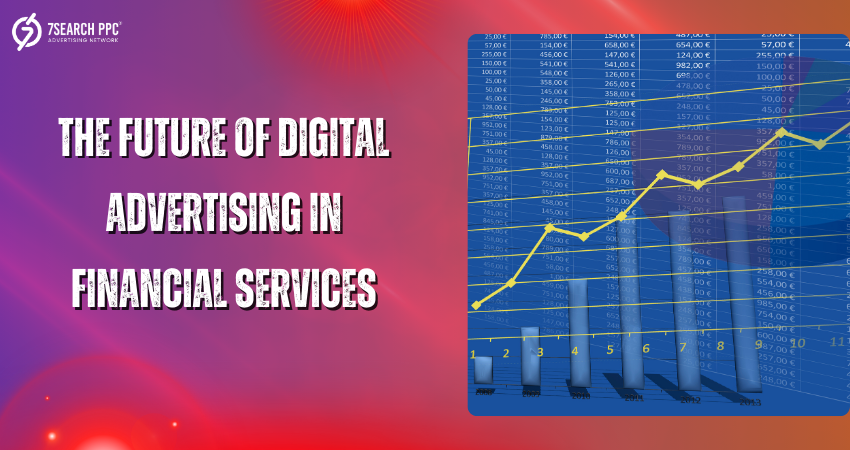In today’s rapidly evolving marketplace, financial institutions are shifting their focus from traditional media to digital platforms. Digital advertising has emerged as a vital tool for companies to engage with modern consumers who increasingly rely on online research, mobile applications, and social media for their financial decisions. This transformation is not just about adopting new technology; it’s a comprehensive shift that influences how brands communicate, target audiences, and measure their advertising efforts. In this article, we explore the transformative power of digital advertising within the financial services digital advertising industry, discuss emerging trends and challenges, and highlight how innovative ad networks like 7search PPC are playing a pivotal role in this evolution.

Boost Your Reach – Advertise Now!
The Digital Shift in Financial Services
The financial sector has historically depended on conventional advertising channels such as television, print, and radio. However, evolving consumer behaviors and the demand for personalized experiences have compelled financial service providers to rethink their marketing strategies. Digital advertising now enables these companies to reach niche markets with precision, customize messages for diverse segments, and track user engagement in real time.
Digital channels offer unprecedented opportunities for brands to establish trust and build long-term relationships with their clients. From online banners and interactive social media campaigns to sophisticated search engine marketing, financial institutions are investing heavily in digital advertising to enhance visibility and generate quality leads. This paradigm shift is underpinned by a growing understanding of digital analytics and customer data, which empowers marketers to craft campaigns that resonate deeply with their audience.
The Role of Digital Advertising in Financial Services
Digital advertising has become indispensable for financial services providers seeking to remain competitive in an increasingly crowded market. It has opened new avenues for customer engagement and brand promotion, enabling companies to communicate complex financial products in a digestible and appealing manner.
Benefits of Financial Services Digital Advertising
Digital advertising offers several clear benefits for financial institutions. It provides cost-effective methods to reach a broad audience, delivers measurable results through real-time analytics, and allows for rapid adjustments in strategy. Campaigns can be fine-tuned to address the specific needs of different customer segments, which is crucial in a field where trust and reliability are paramount.
Enhanced Targeting and Engagement
The precision targeting capabilities of digital platforms allow financial service providers to reach audiences based on demographics, online behavior, and financial interests. This level of targeting not only improves the relevance of ads but also boosts overall engagement. For instance, companies can target potential clients searching for specific financial products or services, ensuring that the right message reaches the right person at the right time.
Real-Time Analytics and Adaptability
Another significant advantage of digital advertising is the availability of detailed performance metrics. Financial institutions can monitor impressions, click-through rates, and conversion data in real time, allowing them to quickly adjust strategies. This agility is essential in an industry where market conditions and consumer preferences can change rapidly. Marketers can optimize campaigns on the fly, ensuring they deliver the best possible return on investment.
Challenges in Financial Digital Advertising
While digital advertising presents numerous opportunities, it also comes with unique challenges, particularly within the highly regulated financial sector.
Advertising Liability Insurance Concerns
One of the primary challenges is managing risk through advertising liability insurance. Financial institutions must ensure that their digital ads comply with industry standards and legal requirements. Advertising liability insurance provides a safeguard against potential claims arising from misrepresentation or inaccurate content. As campaigns grow more sophisticated, balancing creativity with compliance becomes critical for long-term success.
Ensuring Compliance in a Regulated Industry
Financial advertising is subject to strict regulations designed to protect consumers from misleading information. The pressure to remain compliant while still engaging audiences can be overwhelming. Regulatory oversight demands that all content, including Insurance Business Advertising materials, is thoroughly vetted to avoid penalties or reputational damage. This necessitates a careful, well-planned approach that blends regulatory knowledge with creative execution.
Strategies for Successful Digital Advertising in the Financial Sector
To thrive in today’s digital landscape, financial service providers must adopt a multifaceted approach that leverages data, technology, and creative content. A successful digital advertising strategy in the financial sector involves understanding your target audience, choosing the right platforms, and crafting messages that address specific financial needs and concerns.
Leveraging Data-Driven Insights
Data is at the heart of modern digital advertising. By analyzing consumer behavior, financial institutions can create detailed profiles of their target audience. These insights allow for the development of campaigns that speak directly to the needs of potential clients. Data-driven decision making enables marketers to allocate budgets more efficiently, focus on high-impact strategies, and measure success with precision.
Incorporating Creative Ad Formats
The versatility of digital channels means that advertisers are not confined to a single format. For financial services, creative formats such as Insurance Banner Ads and Vehicle Loan Ads play an important role in delivering targeted messages. These visual formats can be highly effective in communicating complex financial information quickly and clearly.
Insurance Banner Ads: Visual and interactive, banner ads can simplify intricate insurance products into engaging graphics and concise text. They are ideal for generating interest and driving traffic to detailed landing pages.
Vehicle Loan Ads: Ads promoting vehicle loans must balance informative content with visual appeal. By incorporating clear calls-to-action and interactive elements, these ads help consumers navigate the often-complicated loan application process.
Integrating with an Ad Network
A critical element for success in digital advertising is partnering with a robust ad network that understands the intricacies of financial marketing. Networks such as 7search PPC offer financial institutions the ability to reach highly targeted audiences, manage campaigns across multiple channels, and optimize performance with expert insights. These networks combine advanced technology with industry expertise, enabling seamless campaign management and providing real-time analytics to ensure optimal results.
The Role of 7search PPC
7search PPC is an ad network that stands out in the digital advertising landscape. With its data-driven approach and extensive experience in financial services, 7search PPC empowers advertisers to design and execute campaigns that yield tangible results. The platform’s comprehensive suite of tools enables marketers to manage bids, track conversions, and adjust strategies based on real-time feedback. This ensures that every advertising dollar is spent effectively, driving growth and increasing market share.
Case Studies and Success Stories
Many financial institutions have already embraced digital advertising, witnessing significant improvements in customer engagement and conversion rates. These case studies illustrate how targeted digital strategies can transform business outcomes in the financial sector.
Impact of Innovative Campaigns
Innovative digital campaigns have not only improved brand visibility but have also enhanced consumer trust. For example, a leading insurance company leveraged digital advertising to promote its Insurance Business Advertising campaign. By using tailored banner ads and strategically placed content, the company experienced a notable increase in website traffic and customer inquiries. Such successes underscore the effectiveness of combining creativity with data-driven targeting.
Growth Metrics in Financial Digital Advertising
The metrics associated with digital advertising campaigns in financial services are compelling. Institutions have reported higher click-through rates, better conversion metrics, and an overall increase in customer acquisition compared to traditional advertising methods. These growth metrics are largely attributed to the ability to refine campaigns in real time and the use of comprehensive analytics to understand consumer behavior. When campaigns are integrated with an ad network like 7search PPC, the impact is even more pronounced, leading to sustained growth and a competitive edge in a crowded market.
The Future of Digital Advertising in Financial Services
Looking ahead, the future of digital advertising in financial services appears exceptionally promising. As technology continues to evolve, new trends and innovations are set to further disrupt the industry and enhance the customer experience.

Emerging Trends and Technologies
Several emerging trends are expected to shape the future landscape of financial services digital advertising:
Artificial Intelligence and Machine Learning: AI-driven tools are increasingly being used to analyze consumer data, predict trends, and automate campaign optimizations. These technologies enable more precise targeting and allow marketers to deliver personalized experiences at scale.
Programmatic Advertising: Automated ad buying platforms are making it easier to target the right audiences at the right time. This trend is particularly beneficial for financial institutions, where precision and speed are crucial.
Interactive and Immersive Content: With the advent of augmented reality (AR) and virtual reality (VR), advertisers are exploring innovative ways to engage consumers. Interactive content is set to become a key component of digital advertising strategies, offering new ways to explain complex financial products and services.
Navigating Challenges for Long-Term Success
Despite the promising trends, financial institutions must remain vigilant about the challenges associated with digital advertising. Compliance issues, data privacy concerns, and the need to continuously adapt to new technologies are ongoing challenges. To navigate these obstacles successfully, companies must invest in advanced analytics, maintain strict regulatory oversight, and partner with experienced ad networks. The combined expertise of platforms like 7search PPC and in-house marketing teams will be crucial in ensuring that digital advertising campaigns are not only innovative but also compliant and effective.
Conclusion
Digital advertising is reshaping the financial services landscape, offering unprecedented opportunities for engagement, growth, and innovation. By embracing digital channels, financial institutions can deliver tailored messages that resonate with modern consumers, all while navigating the complexities of a regulated industry. The integration of creative ad formats—such as Insurance Banner Ads and Vehicle Loan Ads—with advanced analytics and ad networks like 7search PPC is setting a new standard for marketing success. As emerging technologies continue to redefine the possibilities of digital advertising, financial service providers that remain agile and innovative will be well-positioned to thrive in the digital age.
The transformation of digital advertising in financial services is more than a trend; it’s a fundamental shift that is driving the industry toward a future where data-driven insights, compliance, and creativity work together seamlessly. Financial institutions that adopt this integrated approach will not only enhance customer engagement but also build lasting trust and credibility in an increasingly competitive marketplace.

Write a comment ...